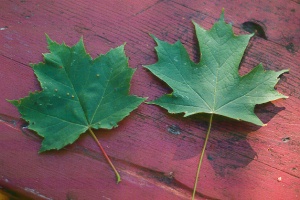|
Back to Deciduous Trees Speckled Alder Mountain Ash Trembling Aspen Birch (Yellow and White) Fire (Pin) Cherry Red Oak Pussywillow |
These two kinds of maples are quite alike, but if one looks closely, a great difference in the leaves of the two can be seen. The sugar maple's leaves have longer, more defined points than the red maple's. Red Maple - Also known as swamp maple, scarlet maple, soft maple, water maple and curled maple, the red maple is so named because its shoots, buds and unfolding leaves are all red in the spring. In the fall however, red maples can turn a variety of brilliant shades, anything from bright yellow to scarlet. Red maples grow well on dry, sandy areas or in places that are wet longer during the year. The red maple can grow up to 125 feet, but usually only reaches heights of 65 to 90 feet. Its relatives include the shrub-like trees striped maple and mountain maple. It is also related to the silver maple, which grows only in swamps and places that have been flooded.
Sugar Maple - This tree, also known as hard maple, rock maple, sweet maple, black maple, sugar tree, curly maple and bird's eye maple, is the tree which provides Canadians all over with one of our most traditional and tasty treats - maple syrup. The sugar maple's leaf is also the emblem of Canada, and can be seen on the Canadian flag. Sugar maples are usually 80 to 90 feet, although they can get as tall as 130 feet. In the fall, the sugar maple leaves turn bright red, hence the red on the Canadian flag, and then turn to yellow later in the season. Sugar maples grow best in rich, fertile and moist areas. |
Home | Natural Environment | History | Industry | Personalities/Stories | Credits/Team
